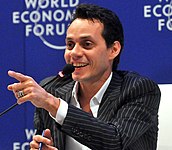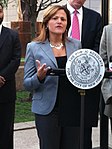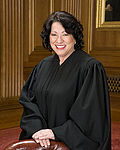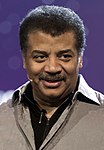Stateside Puerto Ricans
Stateside Puerto Ricans[3][4] (Spanish: Puertorriqueños en Estados Unidos), also ambiguously known as Puerto Rican Americans (Spanish: puertorriqueño-americanos,[5][6] puertorriqueño-estadounidenses),[7][8] or Puerto Ricans in the United States, are Puerto Ricans who are in the United States proper of the 50 states and the District of Columbia who were born in or trace any family ancestry to the unincorporated US territory of Puerto Rico.[9][10]
As Puerto Rico is a U.S. territory, all Puerto Ricans living on both the island and stateside have US citizenship. At 9.3% of the Hispanic population in the United States, Puerto Ricans are the largest Hispanic group nationwide, after Mexicans and are 1.78% of the entire population of the United States.[1] Stateside Puerto Ricans are also the largest Caribbean-origin group in the country, representing over one-third of people with origins in the geographic Caribbean region.[11] While the 2020 Census counted the number of Puerto Ricans living in the States at 5.6 million, estimates in 2022 show the Puerto Rican population to be 5.91 million.[1][12][13]
Despite newer migration trends, the New York metropolitan area continues to be the largest demographic and cultural center for Puerto Ricans in the mainland United States, with the Orlando metropolitan area having the second-largest community. The portmanteau "Nuyorican" refers to Puerto Ricans and their descendants in the New York City area. A large portion of the Puerto Rican population in the United States proper resides in the Northeast and Florida.
Nuyoricans
Income: the turnout rate for those with incomes less than $10,000 was 37.7 percent, while for those earning $75,000 and above, it was 76.7 percent.
Employment: 36.5 percent of the unemployed voted, versus 51.2 percent for the employed. The rate for those outside of the labor force was 50.6 percent, probably reflecting the disproportionate role of the elderly, who generally have higher turnout rates.
Union membership: for union members it was 51.3 percent, while for nonunion members it was 42.6 percent.
Housing: for homeowners it was 64.0 percent, while it was 41.8 percent for renters.
Acosta-Belén, Edna, et al. (2000). "Adíos, Borinquen Querida": The Puerto Rican Diaspora, Its History, and Contributions (Albany, NY: Center for Latino, Latin American and Caribbean Studies, State University of New York at Albany).
Acosta-Belén, Edna, and Carlos E. Santiago (eds.) (2006). Puerto Ricans in the United States: A Contemporary Portrait (Boulder: Lynne Rienner Publishers).
Baker, Susan S. (2002). Understanding Mainland Puerto Rican Poverty (Philadelphia: Temple University Press).
Bell, Christopher (2003). Images of America: East Harlem (Portsmouth, NH: Arcadia).
Bendixen & Associates (2002). Baseline Study on Mainland Puerto Rican Attitudes Toward Civic Involvement and Voting (Report prepared for the Puerto Rico Federal Affairs Administration, March–May).
. In Search of Respect: Selling Crack in El Barrio. New York: Cambridge University Press. 2003
Bourgois, Philippe
(1994). Empire of Dreams. New Haven: Yale University Press.
Braschi, Giannina
Braschi, Giannina (1998). Yo-Yo Boing! Pittsburgh: Latin American Literary Review Press.
Briggs, Laura (2002). Reproducing Empire (Berkeley: University of California Press).
Camara-Fuertes, Luis Raúl (2004). The Phenomenon of Puerto Rican Voting (Gainesville: University Press of Florida).
Cayo-Sexton, Patricia. 1965. Spanish Harlem: An Anatomy of Poverty. New York: Harper and Row
Centro de Estudios Puertorriqueños (2003), Special Issue: "Puerto Rican Politics in the United States," Centro Journal, Vol. XV, No. 1 (Spring).
(2001). The Hispanic Population (Census 2000 Brief) (Washington, DC: U.S. Bureau of the Census, May).
Census Bureau
Census Bureau (2003). 2003 Annual Social and Economic (ASEC) Supplement: Current Population Survey, prepared by the Bureau of the Census for the Bureau of Labor Statistics (Washington, D.C.: U.S. Bureau of the Census).
Census Bureau (2004a). Global Population Profile: 2002 (Washington, D.C.: International Programs Center [IPC], Population Division, U.S. Bureau of the Census) (PASA HRN-P-00-97-00016-00).
Census Bureau (2004b). Ancestry: 2000 (Census 2000 Brief) (Washington, D.C.: U.S. Bureau of the Census).
Chenault, Lawrence R. (1938). The Puerto Rican Migrant in New York City: A Study of Anomie (New York: Columbia University Press).
Constantine, Consuela (1992). "Political Economy of Puerto Rico, New York". The Economist. Vol. 28.
Cortés, Carlos (ed.)(1980). Regional Perspectives on the Puerto Rican Experience (New York: Arno Press).
Cruz Báez, Ángel David, and Thomas D. Boswell (1997). Atlas Puerto Rico (Miami: Cuban American National Council).
Christenson, Matthew (2003). Evaluating Components of International Migration: Migration Between Puerto Rico and the United States (Working Paper #64, Population Division, U.S. Bureau of the Census).
Del Torre, Patricia (2012). "Los grandes protagonistas de Puerto Rico: Caras 2012, Editorial Televisa Publishing International: Special edition on Jennifer Lopez, Calle 13, Giannina Braschi, Ricky Martin, et al.
and Eugene Bucchioni (1975). The Puerto Rican Experience: A Sociological Sourcebook (Totowa, NJ: Littlefied, Adams & Co.).
Cordasco, Francesco
(2004). Barrio Dreams: Puerto Ricans, Latinos, and the Neoliberal City (Berkeley: University of California Press).
Dávila, Arlene
and Ana Y. Ramos-Zayas (2003). Latino Crossings: Mexicans, Puerto Ricans, and the Politics of Race and Citizenship (New York: Routledge).
De Genova, Nicholas
de la Garza, Rodolfo O., and Louis DeSipio (eds) (2004). Muted Voices: Latinos and the 2000 Elections (Lanham: Rowman & Littlefield Publishers, Inc.).
DeSipio, Louis, and Adrian D. Pantoja (2004). "Puerto Rican Exceptionalism? A Comparative Analysis of Puerto Rican, Mexican, Salvadoran and Dominican Transnational Civic and Political Ties" (Paper delivered at The Project for Equity Representation and Governance Conference entitled "Latino Politics: The State of the Discipline," Bush Presidential Conference Center, Texas A&M University in College Station, TX, April 30 – May 1, 2004)
DeSipio, Louis, Harry Pachon, Rodolfo de la Garza, and Jongho Lee (2003). Immigrant Politics at Home and Abroad: How Latino Immigrants Engage the Politics of Their Home Communities and the United States (Los Angeles: Tomás Rivera Policy Institute)
ed. Puerto Rican and Cuban Catholics in the U.S., 1900-1965 (Volume 2, "Notre Dame History of Hispanic Catholics in the U.S." series), (University of Notre Dame Press, 1994).







